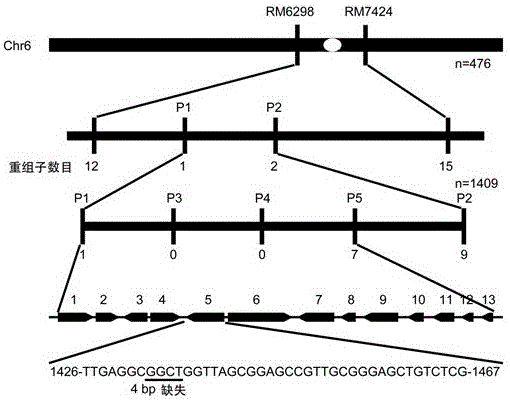Rice seedling stage leaf albino trait gene Oscaacl and application thereof
A technology for rice seedlings and leaves, applied in the fields of application, genetic engineering, plant gene improvement, etc., can solve the problems of difficulty in ensuring the purity of hybrid rice seed production, unstable fertility, etc., and achieve the effect of reducing production risks and improving seed purity
- Summary
- Abstract
- Description
- Claims
- Application Information
AI Technical Summary
Problems solved by technology
Method used
Image
Examples
Embodiment 1
[0049] Example 1 Location of Oscaac1 gene
[0050] 1. Materials and methods
[0051] The rice seedling white leaf mutant caac1 mutant (this mutant is also named as the rice spot mutant caac1, was preserved in the mid-term bank of agricultural germplasm resources of Hubei Province, Institute of Food Crops, Hubei Academy of Agricultural Sciences (preservation number HB216002, dated May 2016 20th) from Zhenshan 97 / Chenghui 178 hybrid offspring, whose phenotype is as follows figure 1 shown. Compared with 9311, the leaves of the mutant caac1 mutant seedlings showed albinism at the two-leaf stage, while the leaves of 9311 were normal green; at the three-leaf stage, the third leaf of the mutant caac1 mutant returned to normal, and 9311 The three leaves are green as well.
[0052] Cultivation method and conditions: After the rice seeds are selected in salt water, they are placed in a petri dish, soaked in the dark at 37°C for 2 days until they are white, and then the seeds are even...
Embodiment 2
[0067] Example 2 Oscaac1 Gene Functional Complementation Experiment
[0068] A complementary vector of 5759bp in length with the promoter, gene fragment and terminator of the OsCAAC1 gene itself was constructed, namely pBWA(V)H-OsCAAC1( image 3 ). Utilize high-fidelity enzymes to use the genomic DNA of rice variety 9311 as a template to amplify the promoter, gene fragment and terminator of the OsCAAC1 gene itself. )H vector (provided by Wuhan Boyuan Biotechnology Co., Ltd.), and then use T4 ligase to ligate the fragment and pBWA(V)H vector backbone to obtain the transgenic vector pBWA(V)H-OsCAAC1. Transform pBWA(V)H-OsCAAC1 into Escherichia coli for amplification, and extract its vector plasmid pBWA(V)H-OsCAAC1.
[0069] The complementary vector pBWA(V)H-OsCAAC1 was used to transform into Agrobacterium EHA105 to transform the rice caac1 mutant mutant, and the transformation method was Agrobacterium-mediated. From Complementary T 1 Randomly select three strains in generati...
PUM
 Login to View More
Login to View More Abstract
Description
Claims
Application Information
 Login to View More
Login to View More - R&D Engineer
- R&D Manager
- IP Professional
- Industry Leading Data Capabilities
- Powerful AI technology
- Patent DNA Extraction
Browse by: Latest US Patents, China's latest patents, Technical Efficacy Thesaurus, Application Domain, Technology Topic, Popular Technical Reports.
© 2024 PatSnap. All rights reserved.Legal|Privacy policy|Modern Slavery Act Transparency Statement|Sitemap|About US| Contact US: help@patsnap.com










